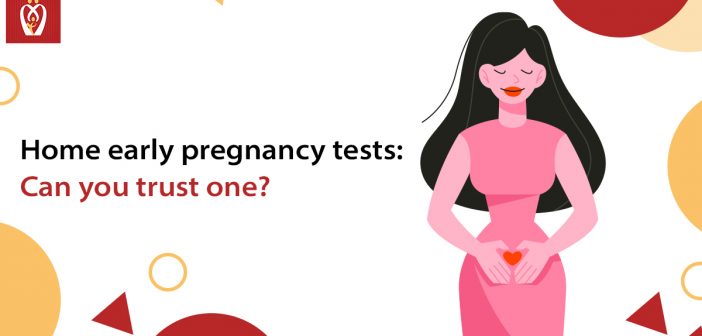Taking a home early pregnancy test can be stressful, wildly, if you’re not convinced the findings are accurate. Learn when and how to use a home early pregnancy test, as well as some of the potential drawbacks.
When is it appropriate to use a home early pregnancy test?
Many home pregnancy tests promise to be accurate as soon as the first day of a missed menstruation, if not sooner. However, if you wait until after the first day of your missed period, you’re more likely to get reliable results.
The placenta forms and generates human chorionic gonadotropin shortly after a fertilised egg attaches to your uterine lining (implantation) (HCG). This hormone is absorbed by the bloodstream and excreted through the urine. The HCG concentration rises quickly throughout early pregnancy, doubling every two to three days. Therefore, the earlier you use a home early pregnancy test, the more difficult it may be to detect HCG.
Remember that ovulation can occur at any point during the month, and the fertilised egg can implant in the uterus at any moment. This can have an impact on the timing of HCG synthesis and detection. You can miscalculate when your period is due if your periods are irregular.
If you need to confirm your pregnancy right away, your health care provider may recommend an ultrasound, a repeat pee test at a lab, or a blood test to assess your HCG levels, depending on how far along you are in your pregnancy.
Are there several kinds of at-home pregnancy tests?
Most tests need you to dip the end of a dipstick into your urine stream or a container of collected pee. The test result is commonly displayed as a plus or negative sign, one or two lines, or the words “pregnant” or “not pregnant” on a strip or screen a few minutes later.
Wait the amount of time specified in the test instructions before checking the findings – generally two or more minutes. A control indicator is a line or symbol that appears in the result pane for most tests. The test isn’t working correctly if the line or mark doesn’t display. Replace the test with a new one.
Some early pregnancy tests for at-home use are more sensitive than others. In other words, in other tests, the amount of HCG that must be identified in the urine to obtain a positive test result is lower.
Before taking a test, make sure to verify the expiration date and read the instructions thoroughly.
What is the accuracy of home pregnancy tests?
Many early pregnancy tests for at-home use claim to be 99 per cent accurate. On the other hand, home pregnancy tests vary in their capacity to detect pregnancy among women who have just missed a period. If you have a negative test but believe you are pregnant, take another one a week following your missing period or consult your doctor.
Is it possible that drugs will affect test results?
Fertility medicines and other treatments containing HCG may interfere with the findings of a home early pregnancy test. However, the accuracy of home pregnancy tests is unaffected by most medications, including antibiotics and birth control pills.
Is it possible that a positive result is incorrect?
It’s possible to get a positive result from a home early pregnancy test even if you’re not pregnant. However, this is uncommon. This is referred to as a false-positive result.
If you had a pregnancy loss shortly after the fertilised egg connected to your uterine lining (biochemical pregnancy) or if you took a pregnancy test too soon after using HCG-containing fertility treatment, you can get a false positive. An ectopic pregnancy, menopause, or issues with your ovaries can all lead to false test results.
Is it possible that a negative result is incorrect?
When using a home pregnancy test, it’s possible to get a negative result when you’re genuinely pregnant. This is referred to as a false-negative situation. For example, if you do the following, you can get a false-negative result:
It’s not a good idea to take the test too soon.
The earlier you take a home early pregnancy test after missing a period, the more difficult it is for the test to detect HCG. Repeat the test one week after missing a period for the most reliable results. If you can’t wait that long, request a blood test from your doctor.
It’s a bad idea to look at test results too quickly.
Allow time for the test to run. Consider using a timer according to the instructions on the package.
Using urine that has been diluted.
Take the test first thing in the morning, when your urine is at its most concentrated, for the most accurate results.
So, what’s next?
Consider the following actions based on your test results:
You’ve taken a few home pregnancy tests and had mixed results, or your home pregnancy test is positive.
Make an appointment with your medical professional. To confirm your pregnancy, you may require a blood test or an ultrasound. The sooner you have confirmation of your pregnancy, the sooner you can start prenatal care.
Your pregnancy test at home came back negative | early pregnancy test
If your period doesn’t start after a few days or a week, repeat the test – especially if you took it before or shortly after a missed period.
You keep getting negative test results, but your period hasn’t started yet, and you’re still worried you’re pregnant.
Consult your healthcare provider for more information.
Thyroid diseases, low body weight, ovary difficulties, extreme exercise, and stress are all causes that might cause skipped menstrual periods (amenorrhea). If you’re not pregnant, your doctor can help you regain control of your menstrual cycle.




